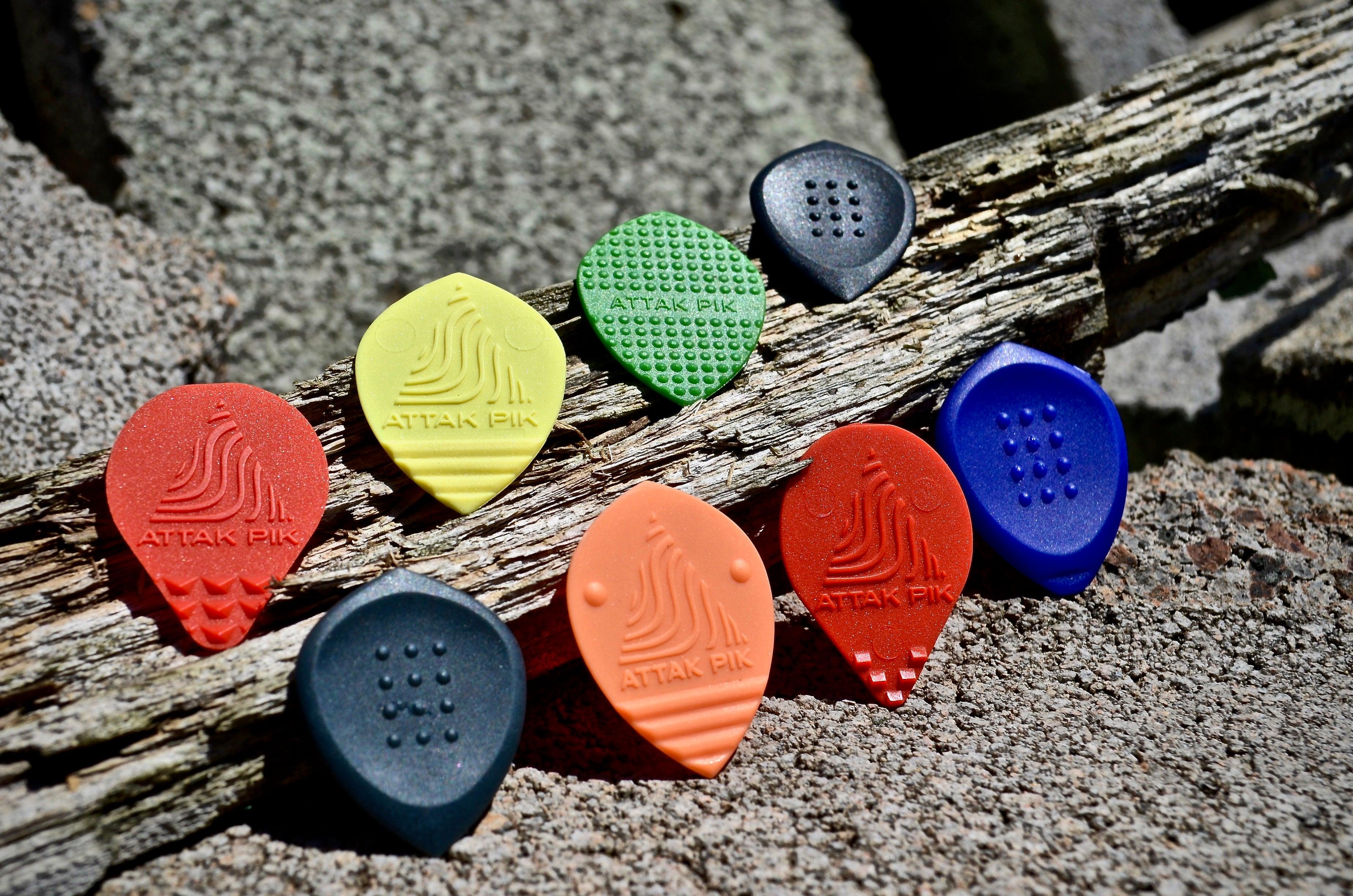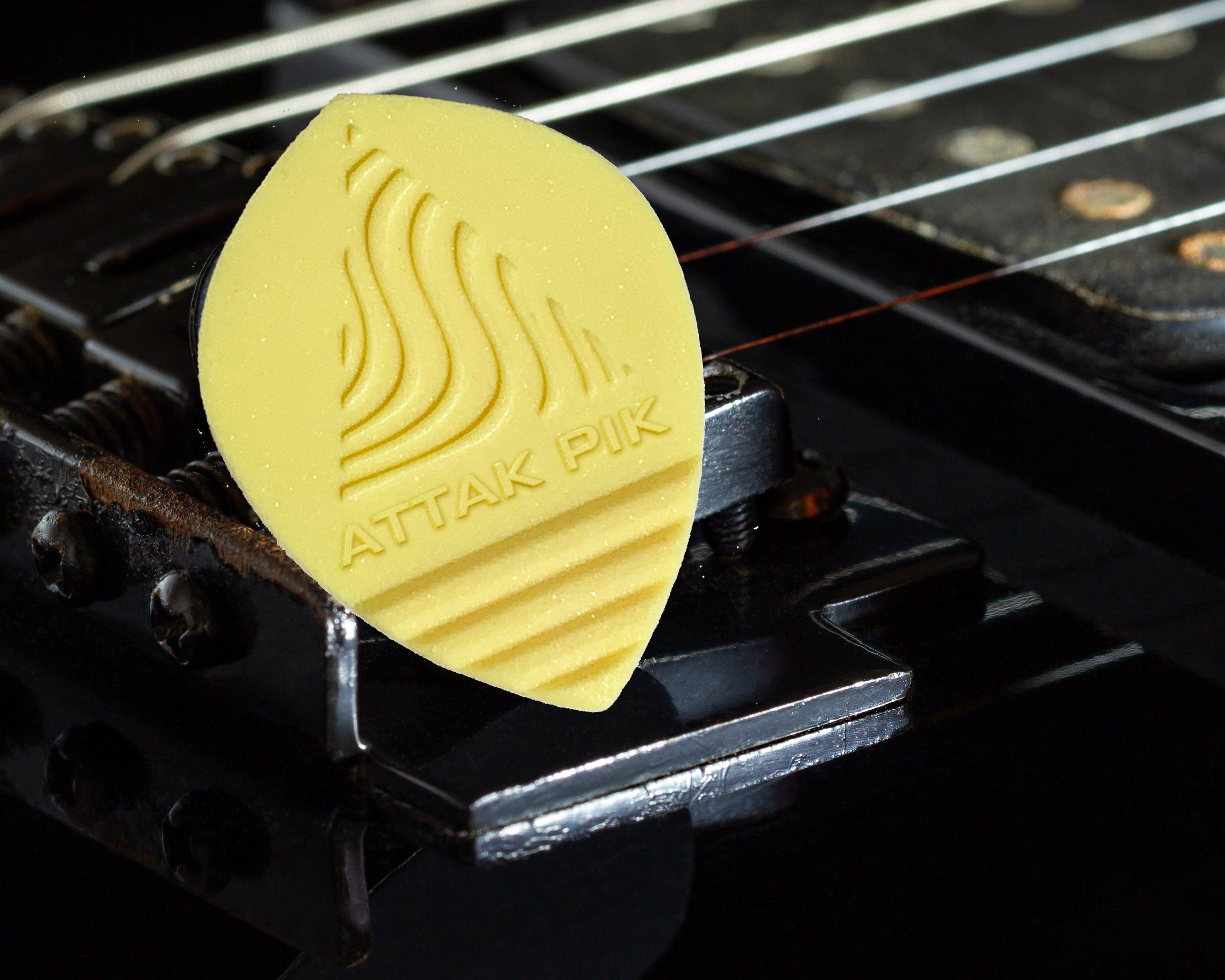If you’ve ever picked up a guitar pick and wondered what its thickness, size, and shape mean, you’re not alone. These seemingly simple objects have a lot of variables that can affect how they feel in your hand and the quality of sound when you play with them.
This article will explore the best practices for choosing a guitar pick, including:
- Understanding Guitar Pick Thickness for Beginners
- How Guitar Pick Size Affects Playing Comfort
- How Guitar Pick Shapes Impact Tone & Style
- Other Considerations When Choosing a Guitar Pick
- Choosing the Ideal Thickness, Size & Shape for You
Understanding Guitar Pick Thickness for Beginners
As a beginner, it’s important to know that the thickness of a guitar pick determines its durability and the sound it produces. There are four main guitar pick gauges to choose from:
- Thin: 0.40mm to 0.60mm thick.
- Medium: 0.60mm to 0.80mm thick.
- Thick: 0.80mm to 1.20mm thick.
- Extra Thick: 1.20mm+ thick.
The right thickness for you will depend on your playing style, skill level, and personal preference. However, there are some general guidelines you can follow to help you decide.
Things to Know About Thin Picks
First and foremost, thin picks are flexible. This flexibility allows for faster, more fluid picking techniques than thick picks do. This makes them a great option for beginners who haven’t mastered technique yet — or for guitarists who enjoy playing intricate melodies and riffs. Additionally, thinner picks tend to be easier to use when strumming chords. They also generate brighter tones, especially on acoustic guitars.
Things to Know About Thick Picks
On the other hand, thick picks are stiffer, heavier, and more durable than their thinner counterparts. They also produce a stronger, more distinct tone than thin picks. When you use a thick pick, it’s easier to attack and dig into the strings. As such, thick picks are an ideal option for guitarists with more aggressive playing styles.
If you want to test the difference between the two, you can record yourself experimenting by playing with two different picks at once — a thin one for strumming chords and a thick one for picking individual notes or power chords. When you’re done practicing for the day, you can play back the recording to see how the different picks affect your tone and enhance your sound.
How Guitar Pick Size Affects Playing Comfort
In addition to different thickness levels, various sizes of picks are available on the market. Size is significant if you’re new to playing guitar, mainly because the size of the pick itself will impact how comfortable you feel when you’re using it.
 For example, if you’re a new player with small hands, a smaller pick will likely be easier to hold and manage. Strumming with a small pick will close the gap between your hand and the strings, making it much easier to switch between different playing techniques. This gives you more control over your sound without being too overpowering when you strike the pick against the strings.
For example, if you’re a new player with small hands, a smaller pick will likely be easier to hold and manage. Strumming with a small pick will close the gap between your hand and the strings, making it much easier to switch between different playing techniques. This gives you more control over your sound without being too overpowering when you strike the pick against the strings.
However, if you’re someone with bigger hands, you’ll probably prefer to use a larger pick. In this case, using a larger pick will make it far less likely for you to fumble or drop it, so you’ll ultimately have more control over the sounds you produce.
How Guitar Pick Shapes Impact Tone & Style
Guitar picks come in a variety of shapes, each of which produces a different tonal effect and compliments certain playing styles. The shape of your pick will impact your overall sound, so it’s important to understand the different shapes and how they will affect your decision.
There are three basic shapes for guitar picks: standard, triangle, and teardrop.
Standard
The standard pick is the most popular style. It has a triangular tip and rounded corners. This makes the pick easier to place between your thumb and forefinger. The rounded corners and pointed tip also help you dig into the strings with precision, which is perfect for strumming chords or picking single notes.
The narrow point allows you to play fast without having to worry about accidentally hitting adjacent strings when you’re trying to hit just one note at a time. You can also use this type of pick to strum up-and-down across multiple strings without getting stuck on any one string.
Triangle
Another popular pick shape is the triangle guitar pick. It is similar to the standard pick in that it has a pointed tip, but has blade-like edges along both sides instead of having rounded corners. These edges are good for playing double stops, as they allow you to strike two strings at once without having much room for error between them.
Teardrop
The teardrop-shaped pick has a rounded tip and straight sides that meet at an angle at the top of the pick. Teardrop-shaped picks make it easier to grip while you’re playing since they’re typically smaller than standard ones. However, they don’t offer as much control over how hard or soft the sound is produced by your strokes on the strings. This can be good or bad depending on what kind of tone you want.
Other Considerations When Choosing a Guitar Pick
There are multiple factors to consider when it comes to choosing a pick. The main ones are thickness, size, and shape. However, there are some additional qualities to keep in mind when you’re making your decision, including:
Material
As you can likely imagine, different guitar pick materials will impact your sound. While there are various materials to choose from, the most common ones used in guitar picks are nylon and celluloid.
Picks of different materials wear down at different rates depending on how often you use them and how aggressively you play. For example, nylon picks are flexible and durable — they’re easy to grip and use, and also last longer than some other materials like celluloids. Celluloid picks provide a warm tone, but are less durable, so they may not last as long as you’d like.
Your choice of pick material will depend on preference, so try out different ones and see what you like!
Comfort
This brings us to our final consideration: comfort.
Ultimately, the pick that is right for you will be the one that feels best between your fingers. The right pick will be the right size relative to your hand, and will offer the perfect amount of control for your playing needs. It should be comfortable for you to use, and, with time, the pick will feel like a natural extension of your hand.
Choosing the Ideal Thickness, Size & Shape for You
A pick is the most basic of guitar accessories — one that every guitarist should have in their collection. And when it comes to good guitar playing, the right pick can make all the difference. That’s why it’s important to understand the various types of picks, their differences, and how they impact your playing — especially if you want to learn how to shred like a pro.
From thin and flexible to thick and rigid picks; small picks for small hands to large picks for big hands; standard style, triangle, or teardrop shape — each of these factors will affect your playing and what sounds you get out of it. Thankfully, Acoustik Attak offers a guitar pick for virtually every playing style and skill level. Whether you’re seeking to produce bright, airy tones or deep, full-bodied sound, our innovative guitar picks offer an ideal solution for every guitarist.
Hopefully, this guide has helped you learn more about the world of guitar picks and made your decision a little easier. When you’re ready to “pick” your pick, be sure to explore our line of acoustic, electric, and bass guitar picks to find the one that’s right for you!



Leave a comment
All comments are moderated before being published.
This site is protected by hCaptcha and the hCaptcha Privacy Policy and Terms of Service apply.